Exercises (2276)
Extension and flexion of the arms in the seated position ► biceps curl
Power
Individual work


In the seated position, grasp the handles with your arms almost straight, place your elbows on the padding, pull the handles upwards (bend your arms, bring your hands to your chest) and do not lose contact between your elbows and the padding.
Starting position:
- Sitting, arms pointing almost straight downwards
- Elbows on the pad (underhand grip)
- Straight, stretched back
Finishing position:
- Arms bent
- Position of the upper body/back unchanged
- Elbows remain in contact with the padding
Extension and flexion of the arms while seated ► db shoulder press / arnold press
Power
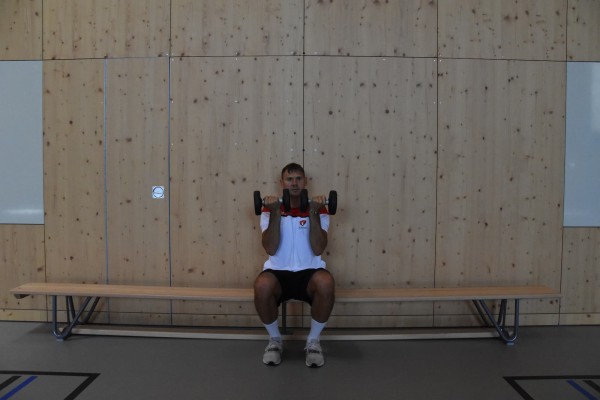
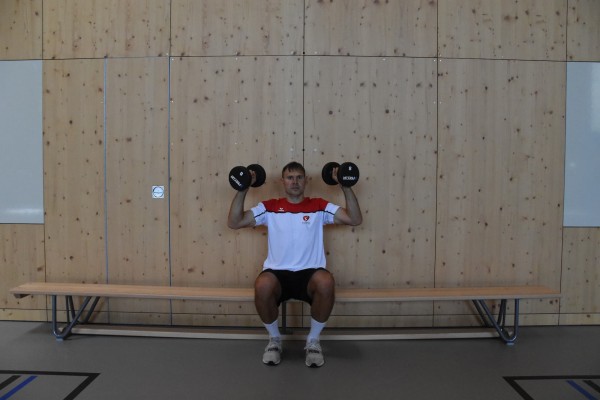

Sit with your arms bent and hold the weights in front of your chest (back straight). The upper arms are close to the body, the elbows are pointing downwards and the forearms and backs of the hands are pointing forwards. From this position, practically bring the arms together in a circular rotational movement overhead. In the end position, the arms are stretched vertically upwards with the backs of the hands pointing backwards. Reverse the sequence of movements to bring the dumbbells back to the starting position towards your chest.
Attention:
Do not fully extend your arms, straight back (possibly back against a wall), actively tense your core.
Lighten:
Less weight.
Harden:
More weight.
Variant:
Exercise performed standing upright.
2 dumbbells
1 flat bench
Extension and flexion of the arms while seated ► lat pull down
Power
Individual work
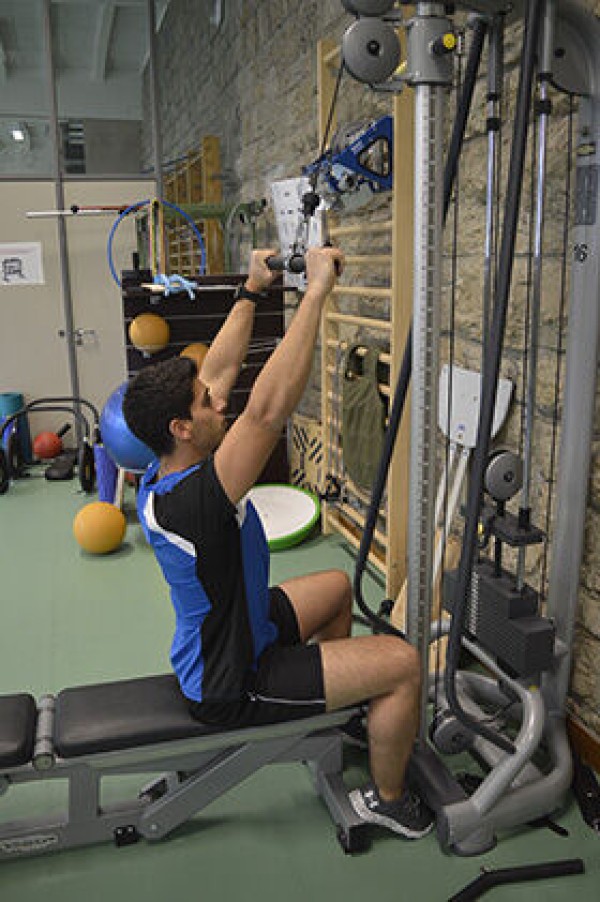
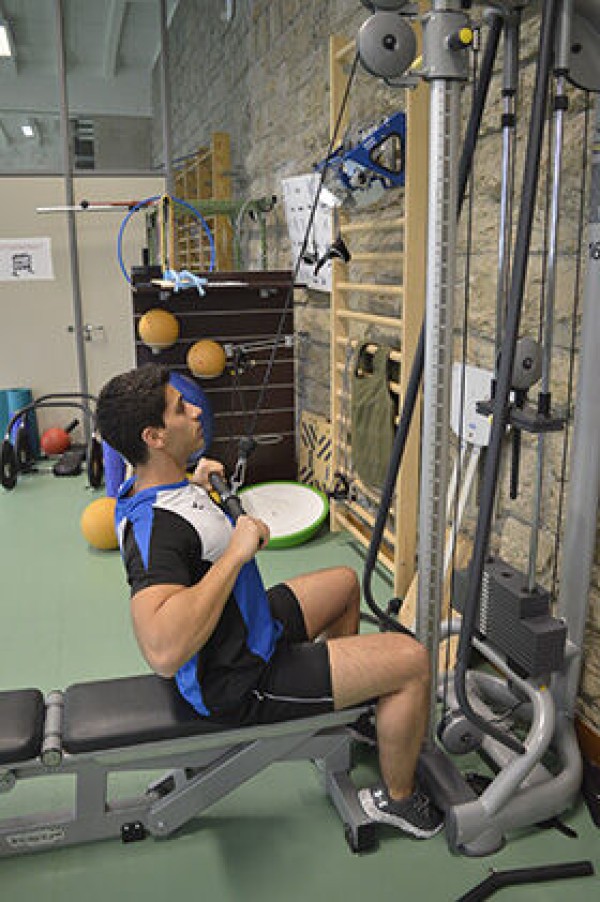
In a seated position, slowly raise the bar towards your chest and back again until your upper arms are almost straight.
Starting position:
- Sitting on the chair/flat bench, upper body tilted slightly backwards
- Arms not fully extended in a high position, hands grasping the bar with an overhand grip
- Back straight, tense core muscles
Finishing position:
- Bar almost touches the chest
- Elbows are behind the body
- Torso remains stable in the starting position
Attention:
Upper body is in a slightly reclined position, keep the back straight throughout the exercise (no movement in the upper body & no hollow back), do not pull into the neck.
1 weight tower/machine ► cable pulley (high)
1 chair/flat bench
Extension and flexion of the arms while seated ► pull down / lat machine
Power
Individual work
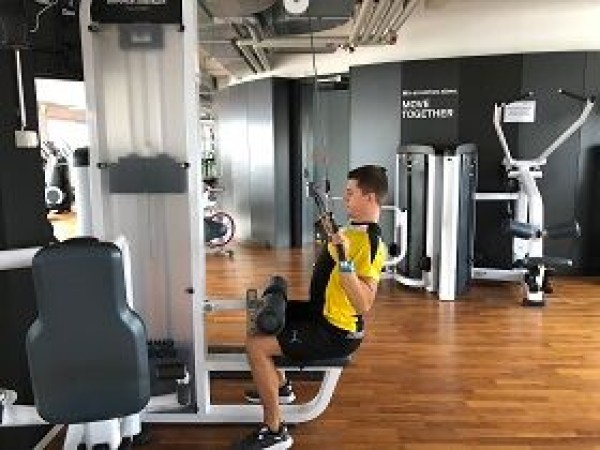
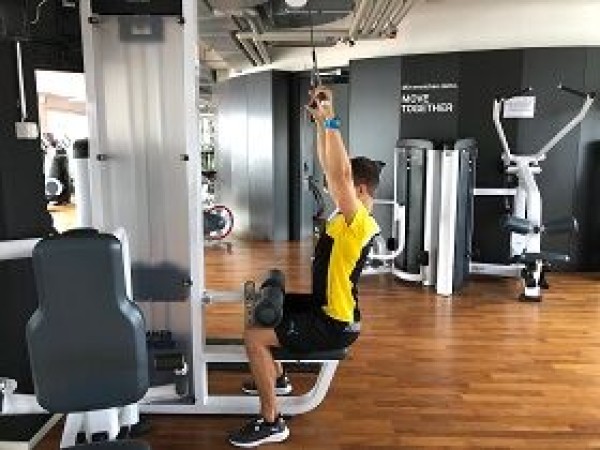
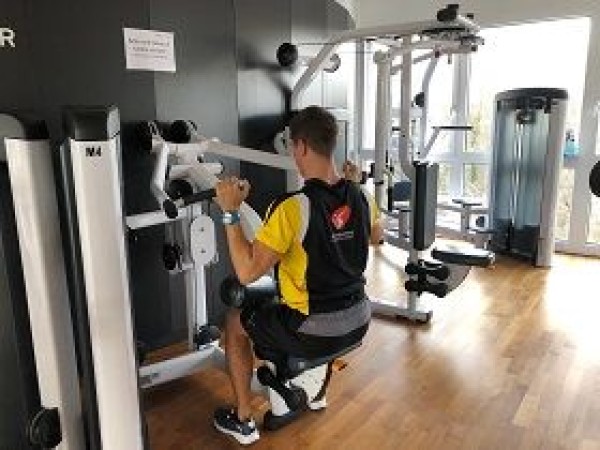
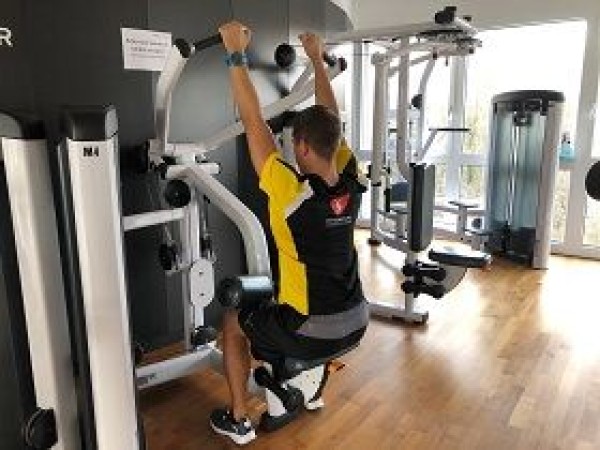
Grab the bar (for the cable pulley) or handles (for the machine), sit down and secure your thighs under the pad. Then pull the bar/handles down towards your sternum and return to the starting position.
Starting position:
- Sit with your upper body stretched out (slightly reclined)
- Tense your core muscles
Finishing position:
- Elbows pulled back and down
- Bar under your chin / hands almost at shoulder height
Extension and flexion of the arms while seated ► seated dumbell z-press
Power
Individual work


Sit upright with your legs stretched out on the floor, hold a dumbbell in each hand and place your arms at an angle next to your body (elbows pointing downwards close to your body, forearms pointing horizontally upwards, dumbbells at shoulder height). Extend your arms overhead (hold them up) and lower them back to the starting position.
Attention:
Always keep your back straight (body tension).
Lighten:
Bend your legs (slightly); less weight.
Harden:
More weight.
2 dumbbells
Extension and flexion of the arms while seated ► Shoulder press
Power
Individual work

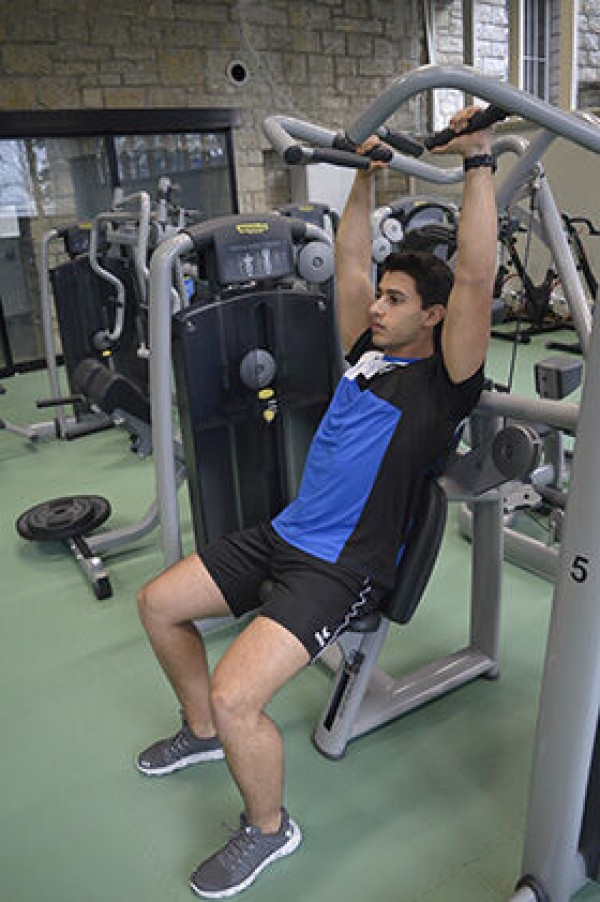
In a seated position, slowly push the bar upwards and return to the starting position.
Starting position:
- Sitting on the chair/flat bench, upper body erect (torso tensed)
- Hold the bar with an overhand grip, wrists fixed (no bending), elbows approximately at chest height.
Final position:
- Arms almost fully extended in a high position
Attention:
Avoid a hollow back position (tense your stomach), shoulders (especially shoulder blades) remain low. Arms always move at the same angle as the bar.
1 strength tower/machine ► shoulder push-up
1 chair/flat bench
Extension and flexion of the arms while seated ► Shoulder press
Power
Individual work
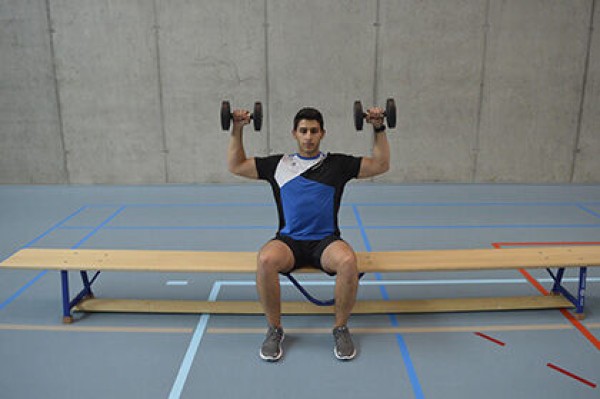
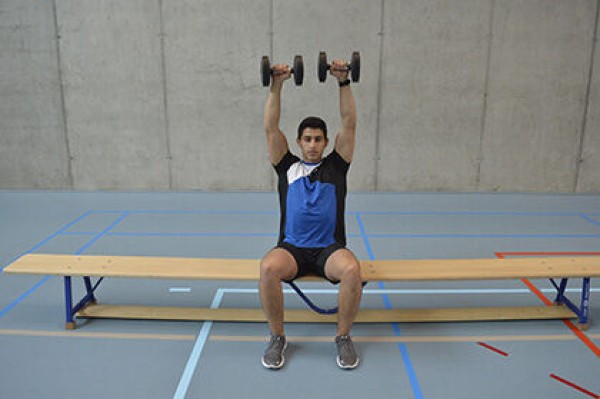
Sit upright on the long bench (or the Swedish box top), arms bent at shoulder height with the dumbbells in your hands (right angle at the elbow joint), palms facing forwards (overhand grip), bring your arms/dumbbells together above your head and lower them back to the starting position.
Attention:
Do not fully extend your arms, straight back (possibly back against a wall), actively tense your torso.
Lighten:
Less weight.
Harden:
More weight.
Variant I:
Exercise performed in a standing position.
Variant II:
After each exercise, bring your arms/dumbbells together in front of your head (elbows at shoulder height) with your palms facing your face.
1 long bench or 2 vaulting box elements (incl. upper section)
2 dumbbells
Extension and flexion of the arms while seated ► triceps extension
Power
Individual work

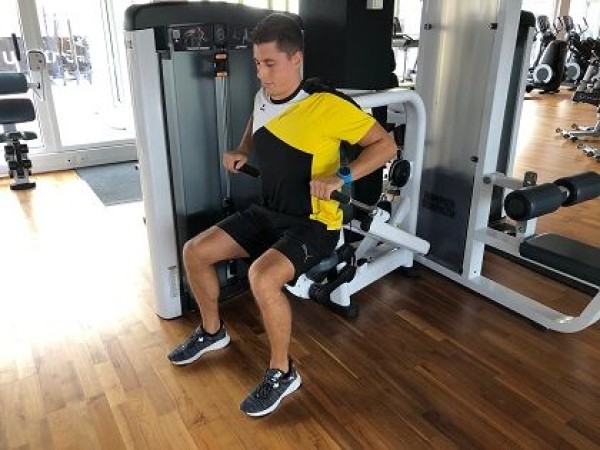
While seated (body slightly forward), bend the arms (elbows close to the body at about chest height), press down on the handles (holding them in the upper grip) and return to the starting position (stretch and bend the arms).
Starting position:
- Sitting with arms bent
- Straight back stretched, with the upper body leaning slightly forwards
Finishing position:
- Arms almost stretched (pointing towards the floor)
Extension und Flexion der Arme im Sitz/Kniestand ► behind the neck lat pull down
Power
Individual work
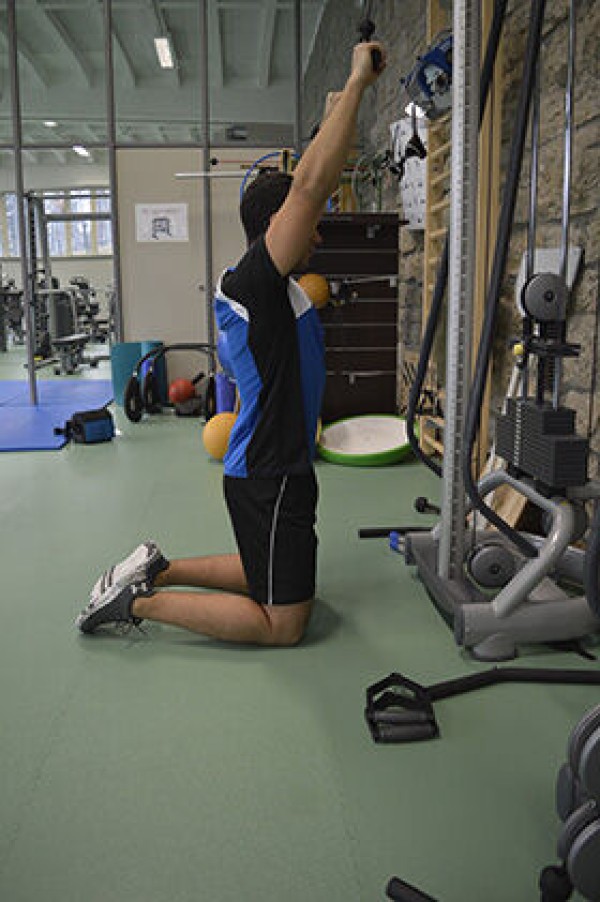
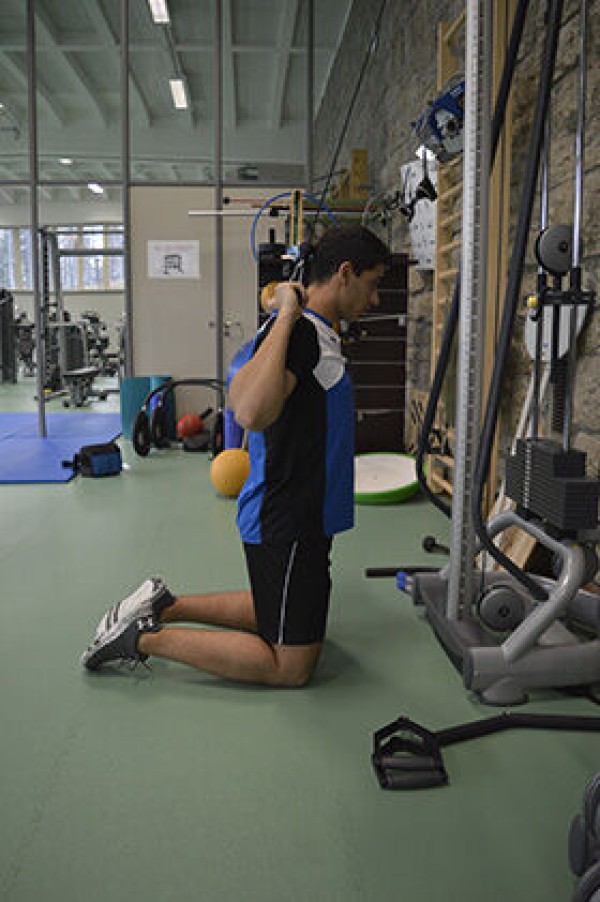
In a seated (or kneeling) position, hold your almost straight arms up, slowly bring the bar behind your head and back to the starting position.
Starting position:
- In a seated or kneeling position, upper body upright (torso tensed)
- Arms almost fully extended in upright position, hold bar in upper grip.
Finishing position:
- Pull bar behind head
- Torso remains upright
Attention:
Exercise for advanced users. Only perform this exercise if you have shoulder mobility (bring both arms overhead behind your head without compensating in the lumbar spine with a hollow back)! Keep your shoulders low.
Variant:
The wider the grip, the more the upper back and shoulder muscles are used.
1 weight tower/machine ► cable pulley (high)
1 chair/flat bench (optional)
Extension and flexion of the arms while standing
Power
Individual work
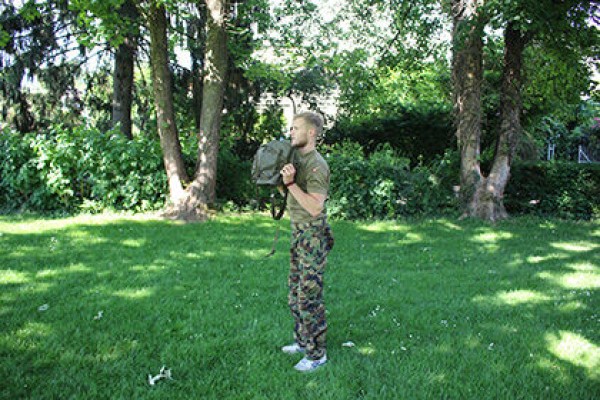
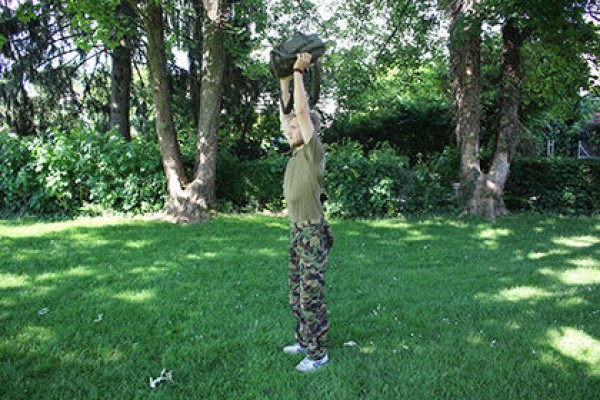
Hold an object (e.g. rucksack, weight disc, sandbag, tyre) with both hands at chest height and lift it by stretching your arms above your head, then bend your arms to return the object to the starting position.
Attention:
Keep your back straight.
Lighten:
Less weight/load.
Harden:
More weight/greater load.
1 weight disc/(medicine) ball/sandbag/fighting backpack
1 helmet/1-2 PET bottles (1.5 litres) ► make the exercise easier
1 tyre (PUCH) ► make the exercise more difficult (additional weight)
Extension and flexion of the arms while standing
Power
Partner work
1 trainee & 1 helper ► note change of position
(= double the time required; for lesson planner see Organisation Kraft: Info button Execution)


Practitioner: Stand upright with a shoulder-width stance frontally facing your partner at a distance of approximately one arm's length and hold their hands at chest height, bend and stretch the arms to tilt the upper body forwards and return to the starting position (chest press, push the arms out forwards and pull them towards the body).
Partner: Standing upright, counter the movement of the active participant.
Attention:
Elbows bent approx. 45° from the upper body ("A" shape with the arms), shoulders are fixed and pushed down towards the hips.
Lighten:
Less resistance/pressure from your partner.
Harden:
Stronger resistance/pressure from your partner.
No material required
Extension and flexion of the arms while standing
Power
Individual work

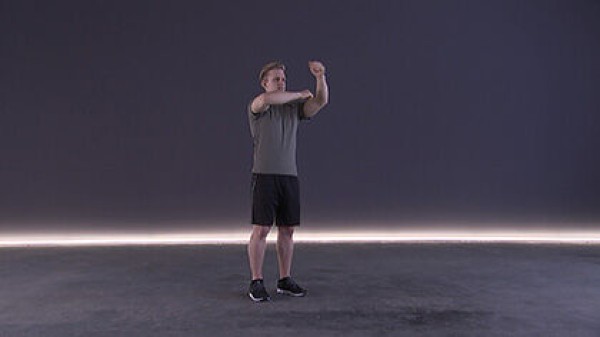
A distinction is made between the left-handed and right-handed stance. Right-handers take the left stance (left foot in front), while left-handers take the right stance (right foot in front). The left-hand stance: The left foot is placed one step forwards from a parallel stance approximately shoulder-width apart so that the right hand is behind. The right hand corresponds to the striking hand, the left hand to the leading hand. The distance between the two feet is approximately one shoulder width, with the feet on a diagonal to each other. The front foot stands on the entire sole, the heel of the back foot is raised. Both feet point forwards and the weight is evenly distributed over both legs. The front shoulder is turned slightly inwards. The whole body is slightly crouched, the knees are slightly bent and soft. The striking hand is placed in front of the chin and rests against the body. The lead hand is in front at eye level. The fists point outwards with the back. The arms are in front of the body and the elbows point downwards so that the arms cover the body. Alternate one arm in front of the other (circular movement), keeping the elbows practically stable at the same height.
Attention:
Always hold your arms up (chin or eye level).
Lighten:
Lower your elbows (circular movements at chest height).
Harden:
Hold additional weight on your arms or in your hands.
2 weight cuffs/weight balls/dumbbells ► make the exercise more difficult (additional weight)
Extension and flexion of the arms while standing
Power
Individual work
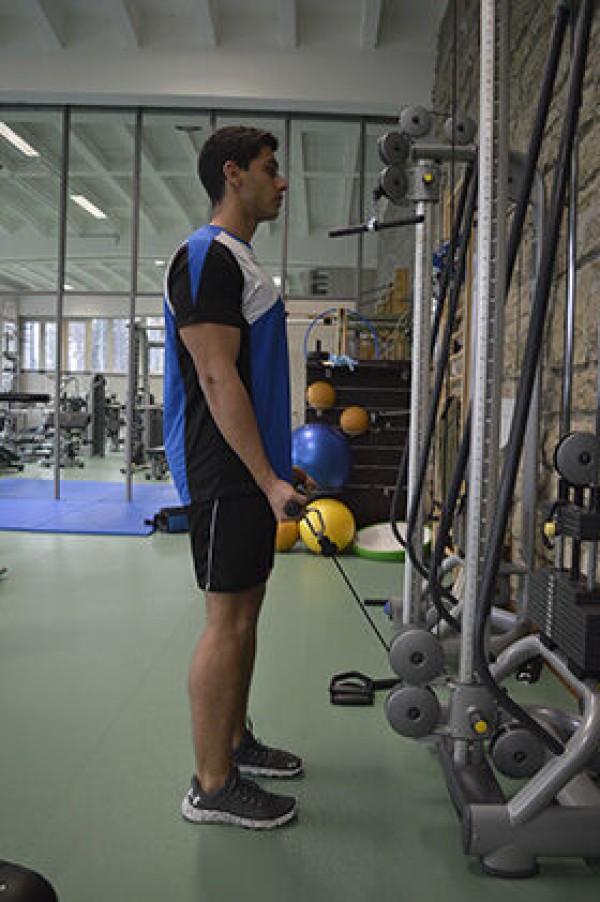
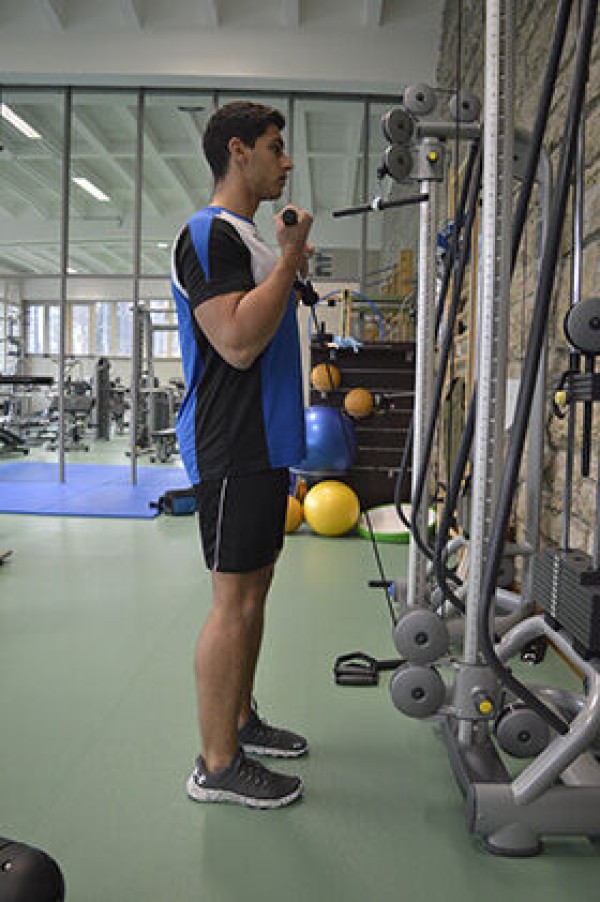
Stand upright, elbows fixed at the waist, almost straight arms holding the bar in front of the body at hip height. Slowly pull the bar up towards your chest in a controlled manner and return to the starting position. The movement comes from the elbow joint.
Starting position:
- Stand upright (shoulder-width apart or in a lunge)
- Arms are almost straight, elbows are fixed at the waist
- Grip the bar in front of the body at hip height
Finishing position:
- Bar at chest height with arms bent
- Elbows still fixed at the waist
- Upper body position remains stable
Attention:
If you use too much weight, there is a risk that you will work with momentum and therefore put more strain on the back muscles and less on the arm flexors. Position your arms in front of your body and always extend your arms as far as they will go. Keep your shoulders fixed (press towards your hips).
1 weight tower/machine ► cable pulley (deep)
Extension and flexion of the arms while standing
Power
Individual work

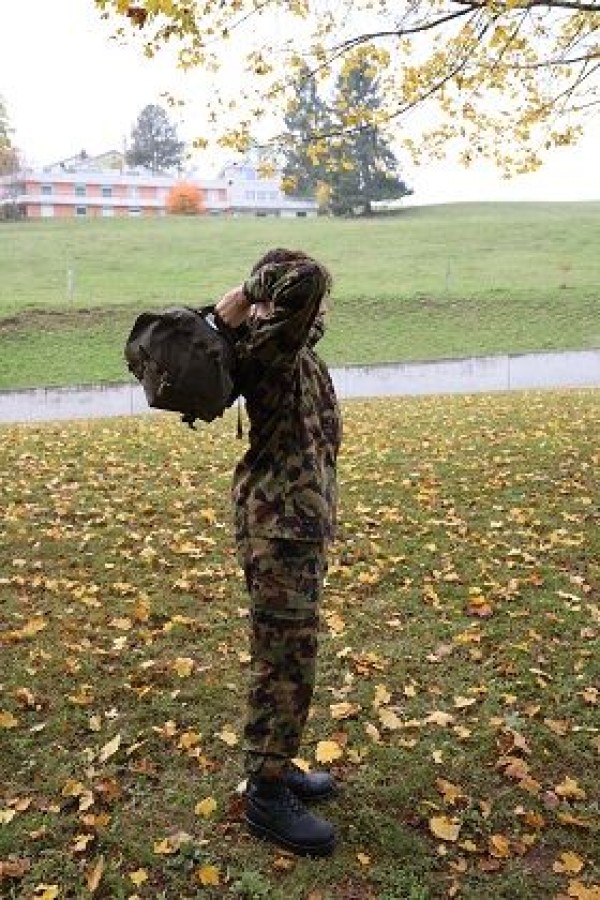
Stand upright (feet parallel or slightly offset), hold object (e.g. tyre or rucksack) above head with arms almost outstretched, bend and stretch arms (bring object behind head, movement in elbow joint, upper arms stable).
Attention:
Tighten your stomach, straight back, elbows remain shoulder-width apart in the same place at head height.
Lighten:
Less weight.
Harden:
More weight.
1 tyre (PUCH)/fighting rucksack/weight plate
1-2 PET bottles (1.5 litres)/1 helmet ► make the exercise easier
1 sandbag/tyre (DURO) ► make the exercise more difficult (additional weight)
Extension and flexion of the arms while standing
Power
Individual work
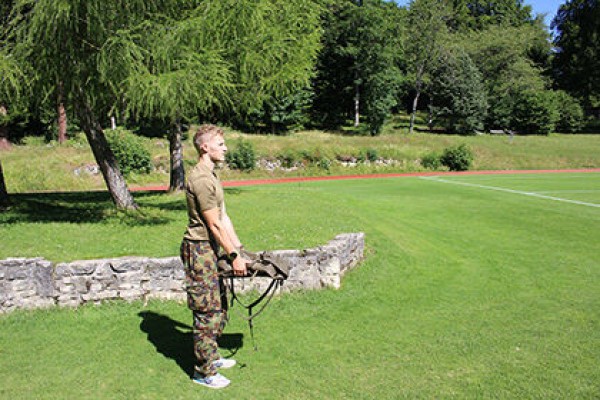
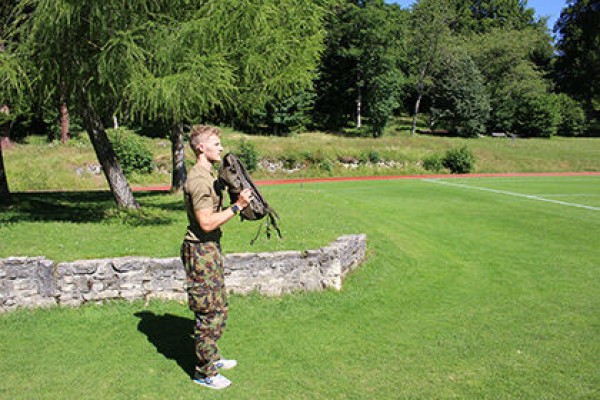
Stand upright with your feet shoulder-width apart, hold the object (e.g. rucksack) at hip height with your arms hanging straight, raise the rucksack to your chest by bending your arms and lift it over your head to stretch your whole body. Lower the object again by reversing the sequence of movements.
Attention:
Work without momentum if possible, avoid a hollow back position in the end position (actively tense the torso), fix the shoulders (press towards the hips).
Lighten:
Less weight/load.
Harden:
More weight/greater load.
1 combat rucksack/(medicine) ball
1 helmet ► make the exercise easier
1 weight disc/sandbag/tyre (PUCH) ► make the exercise more difficult (additional weight)
Extension and flexion of the arms while standing
Power
Individual work
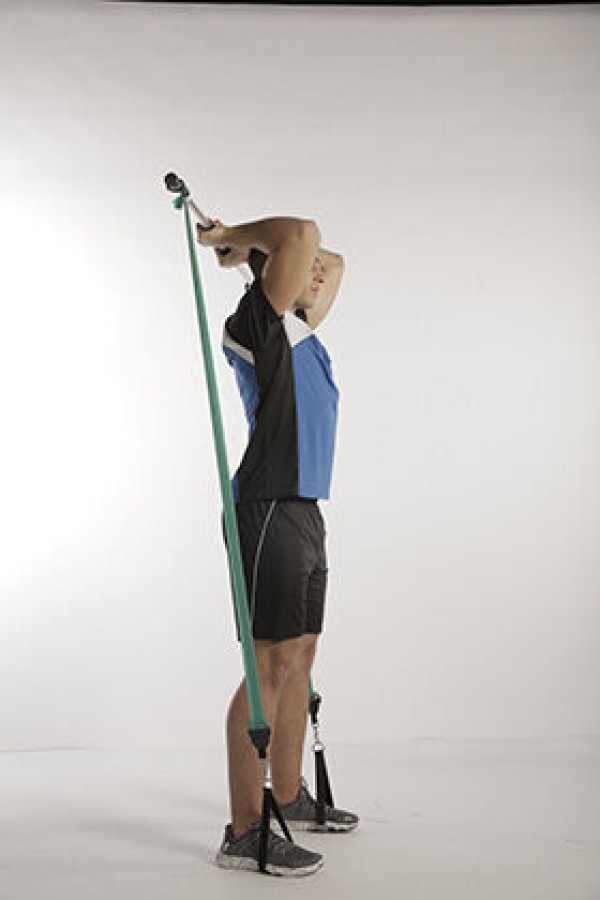
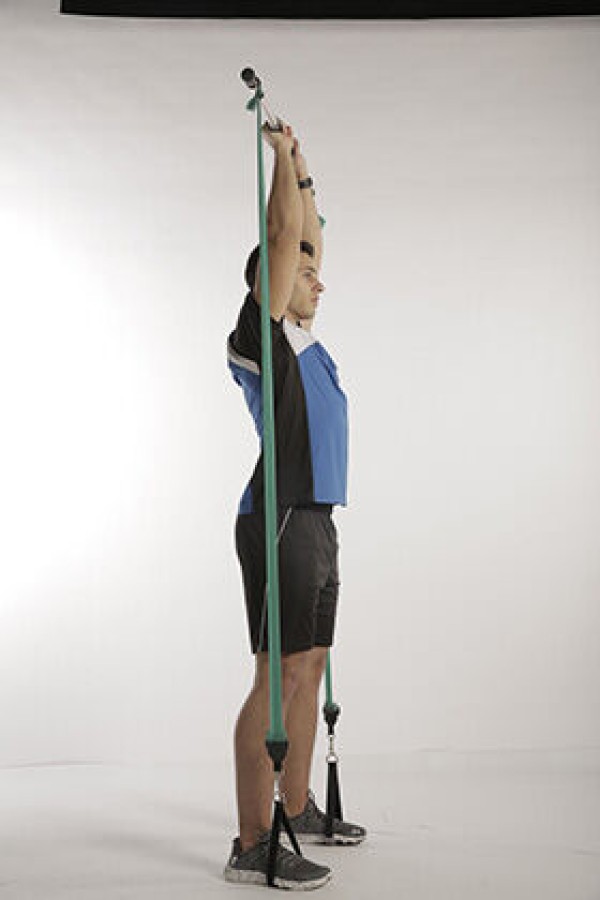
Stand upright with your feet shoulder-width apart, feet in the loops, hold the gymnastics pole behind your head with both hands, elbows bent and close to your head, back of your hands pointing downwards, stretch your (lower) arms and bend back to the starting position.
Attention:
Movement only takes place in the elbows, which remain close to the head, no hollow back (tense torso).
Lighten:
Choose less strong elastic bands; roll up the elastic bands less.
Harden:
Choose stronger elastic bands; roll up the elastic bands more.
1 gymnastic bar with elasticated straps
Extension and flexion of the arms while standing
Power
Individual work
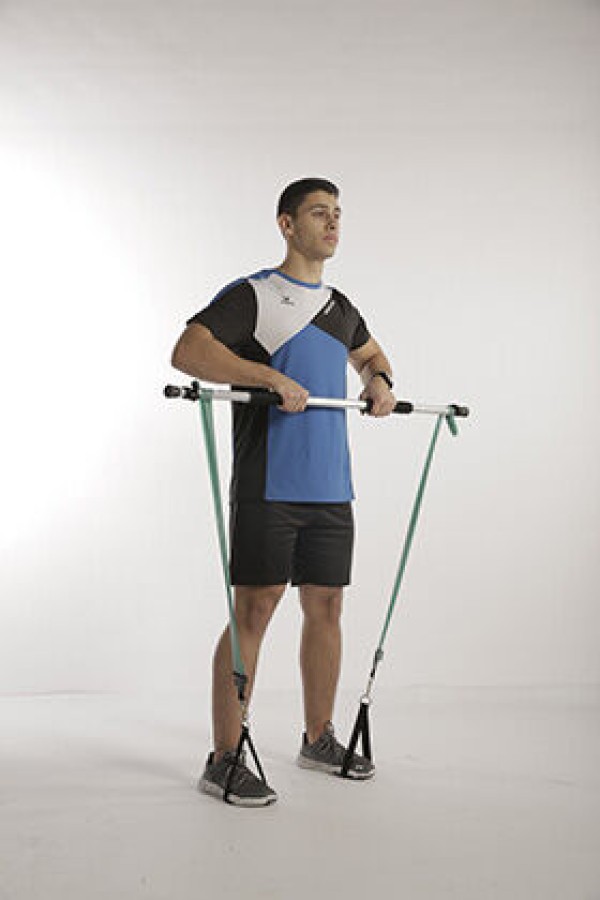
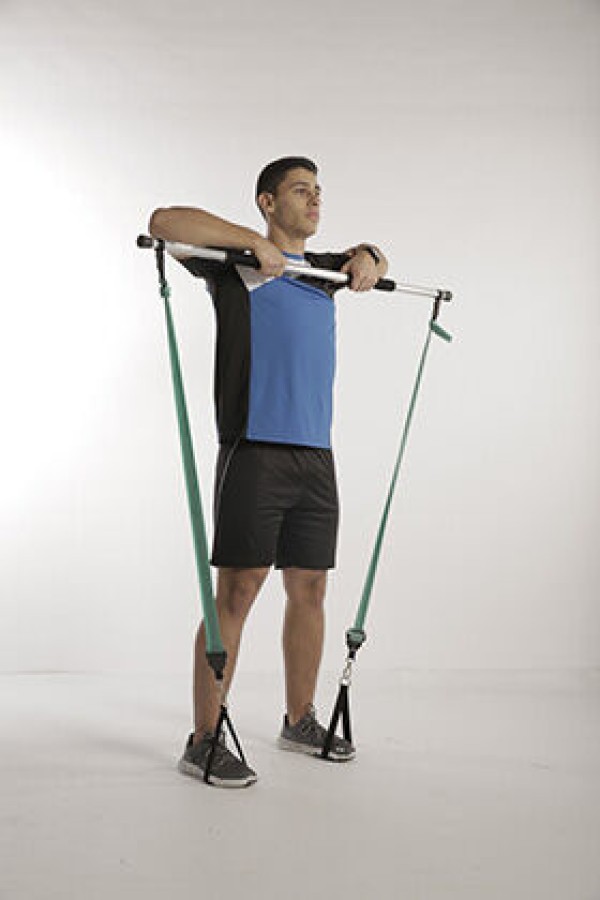
Stand upright with your feet in the loops, hold the gymnastics pole at about hip height in front of your body, close the upper grip of your hands in the centre of the pole (palms facing down), pull your hands close to your body up to chest height and lower them back to the starting position.
Attention:
The movement only takes place in the arms (upper body remains stable), no hollow back (tense torso).
Lighten:
Choose less strong elastic bands; roll up the elastic bands less.
Harden:
Choose stronger elastic bands; roll up the elastic bands more.
1 gymnastic bar with elasticated straps
Extension and flexion of the arms while standing
Power
Individual work

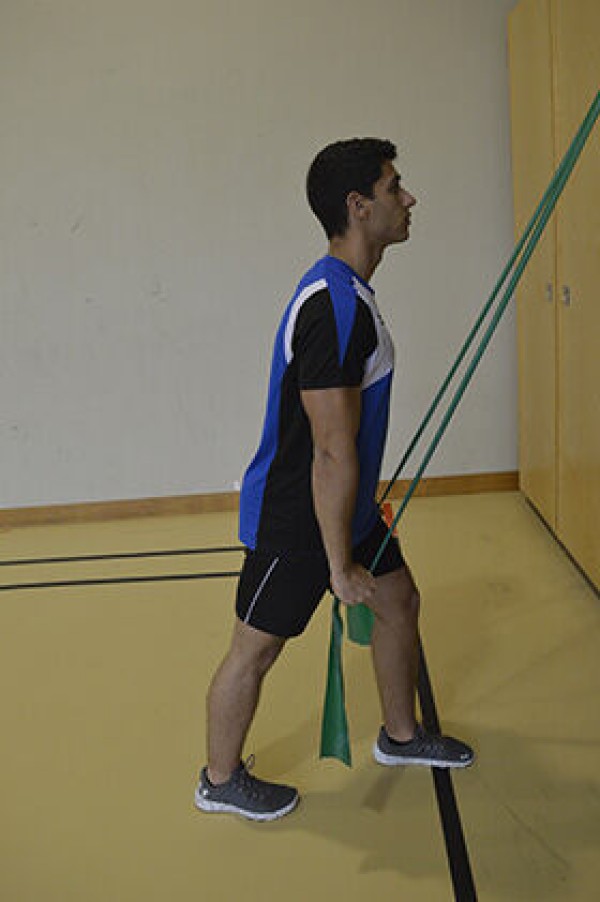
Attach the elastic band to the wall bars (or e.g. a tree) slightly above head height, take a stepping position facing the elastic band, upper body slightly bent forward, arms bent (hands approximately at chest height) and hands holding the elastic band (the band is taut), upper arms resting against the body, stretch arms and bend back to starting position without changing the position of the elbows (only the elbow joint moves).
Attention:
The upper body and upper arms do not move (the movement only takes place in the forearms).
Lighten:
Select a rubber band with less resistance.
Harden:
Select a rubber band with greater resistance.
1 elasticated rubber band
1 wall bar/tree
Extension and flexion of the arms while standing
Power
Individual work
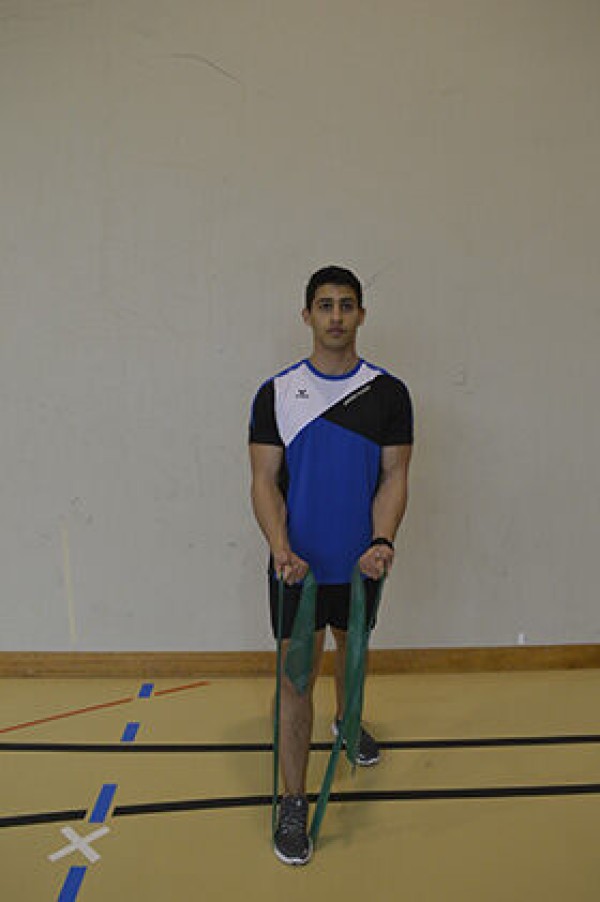

Stepping position, step onto the centre of the elastic band with your front foot, hold the band slightly in front of your body at about hip height with your arms hanging down, bend your arms (bring your hands to your chest) and stretch back to the starting position, keeping your elbows close to your body.
Attention:
Movement only takes place in the elbows (do not lean backwards with your upper body for support).
Lighten:
Choose a rubber band with less resistance.
Harden:
Choose a rubber band with more resistance.
1 elasticated rubber band
Extension and flexion of the arms while standing
Power
Individual work
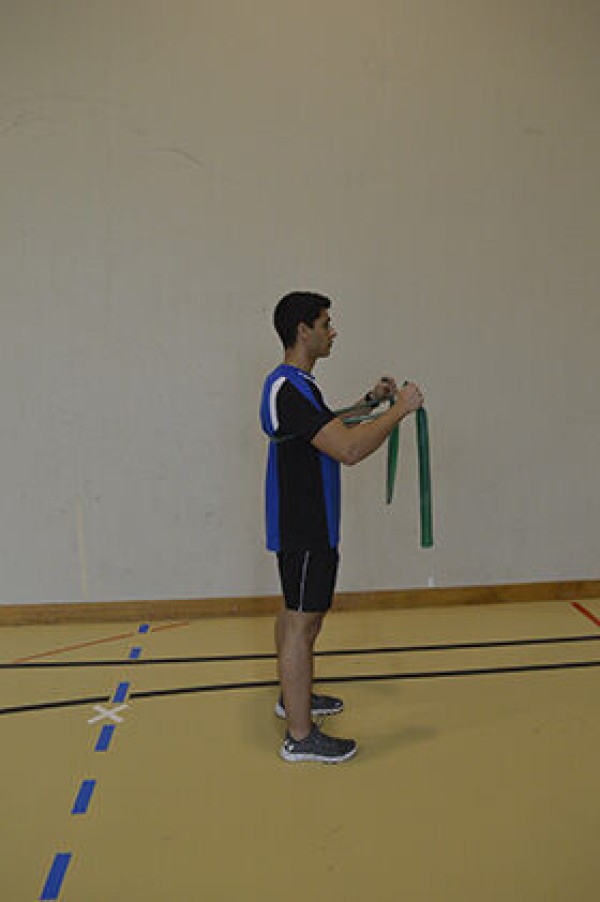
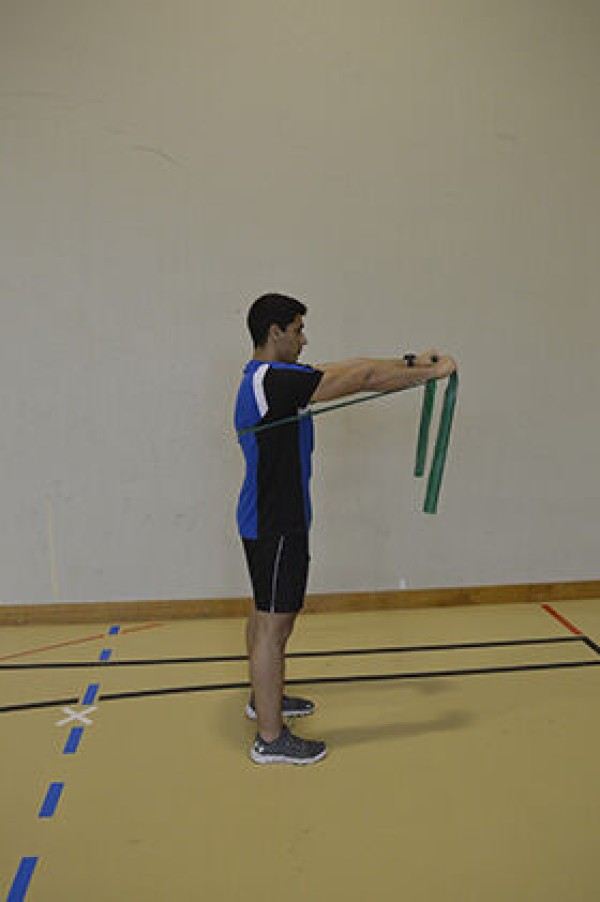
Stand upright, shoulder-width apart, hold one end of the elastic band in front of your chest with your arms bent, with the band running behind your body (approximately armpit height), stretch your arms and bend back to the starting position.
Attention:
Do not pull your shoulders up/to your neck.
Lighten:
Choose a rubber band with less resistance.
Harden:
Choose a rubber band with greater resistance.
Variation:
Fix the band behind the body at shoulder height on the wall bars/on the tree.
1 elasticated rubber band
1 wall bar/tree ► variation of the exercise
Extension and flexion of the arms while standing
Power
Individual work


Stand upright (feet parallel or slightly offset), hold a weighted disc above your head with your arms almost outstretched, bend and stretch your arms (bring the disc behind your head, movement in the elbow joint, upper arms stable).
Attention:
Tighten your stomach, straight back, elbows remain shoulder-width apart in the same place at head height.
Lighten:
Less weight.
Harden:
More weight.
1 weight disc
Extension and flexion of the arms while standing
Power
Individual work

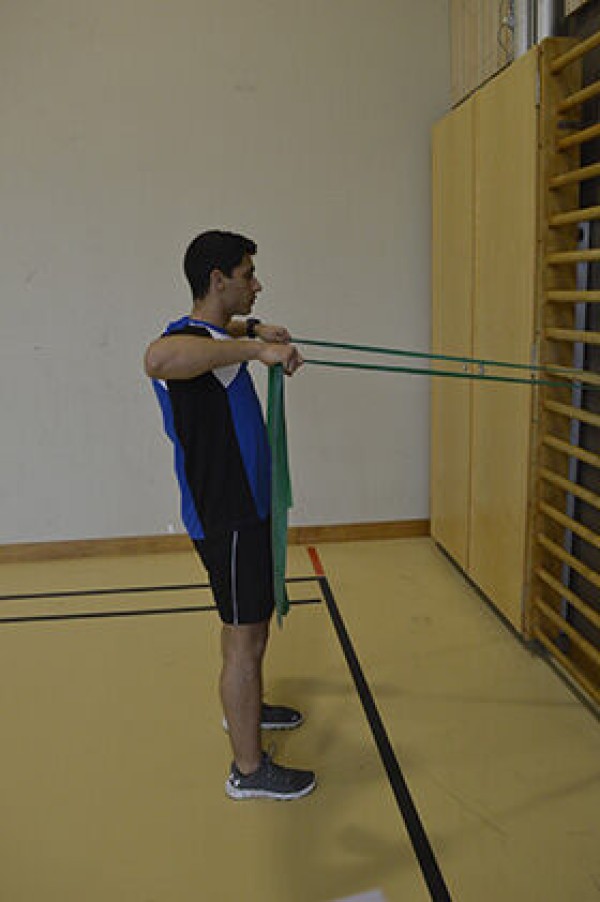
Light step stance or upright, shoulder-width stance facing the wall bars (or a tree, for example), fix the elastic band at shoulder height on the wall bars (on the tree), arms stretched out horizontally forwards (backs of hands pointing upwards), pull your elbows back at shoulder height, bringing your hands towards your chest and pulling your shoulder blades together.
Attention:
Do not arch your back (tighten your stomach).
Lighten:
Choose a rubber band with less resistance.
Harden:
Choose a rubber band with more resistance.
1 elasticated rubber band
1 wall bar/tree
Extension and flexion of the arms while standing
Power
Individual work
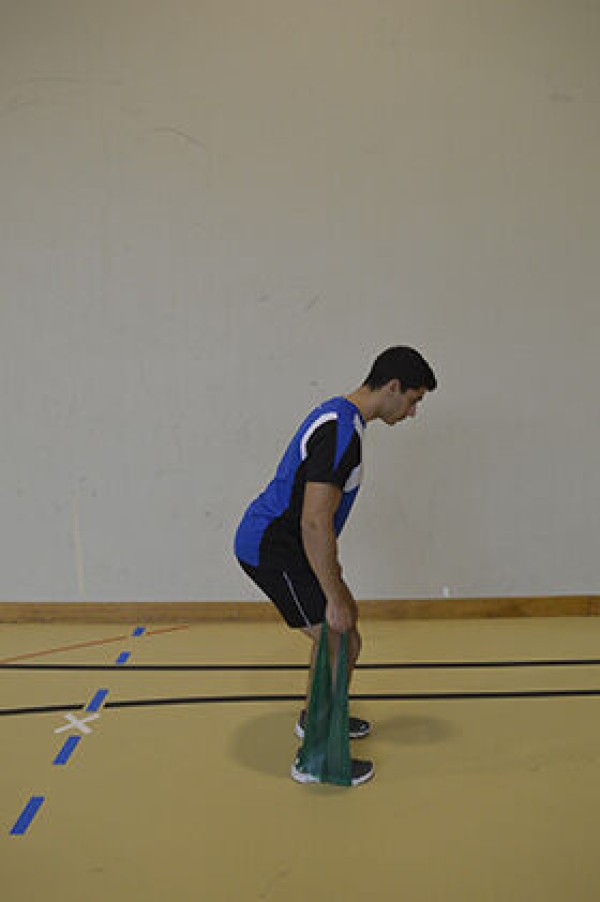
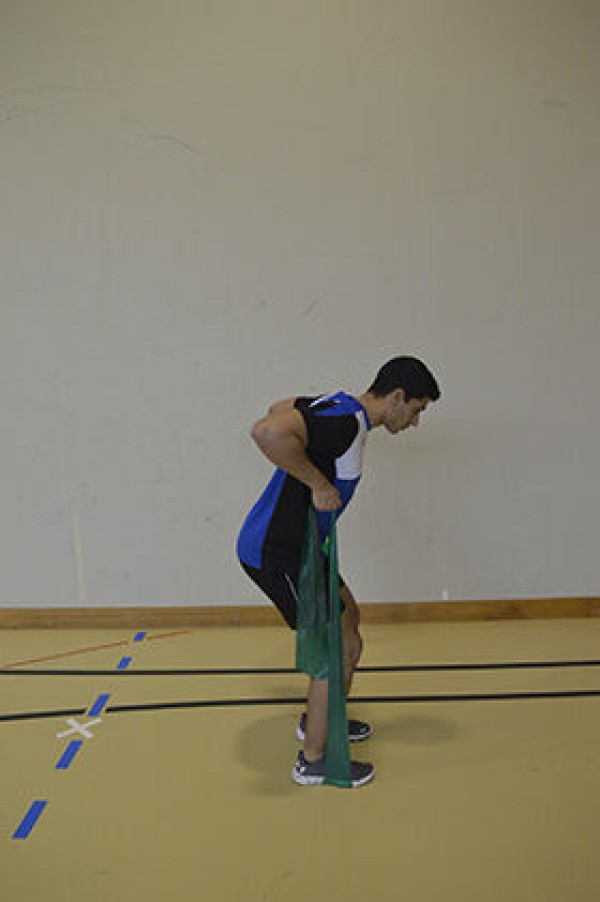
Stand shoulder-width apart in the centre of the elastic band, knees slightly bent and upper body tilted forwards, arms straight and hanging downwards, grasp one end of the elastic band with each hand, elbows close to the body backwards/upwards (pull shoulder blades together; pull hands towards chest) and return to starting position.
Attention:
Keep your upper body stable, do not arch your back (tighten your stomach).
Lighten:
Choose a rubber band with less resistance.
Harden:
Choose a rubber band with more resistance.
1 elasticated rubber band
Extension and flexion of the arms while standing
Power
Individual work
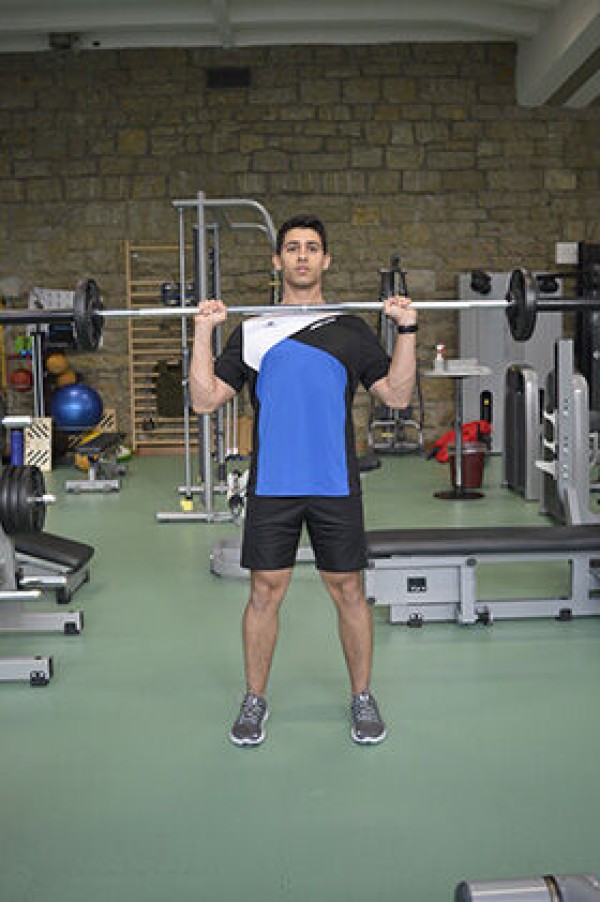
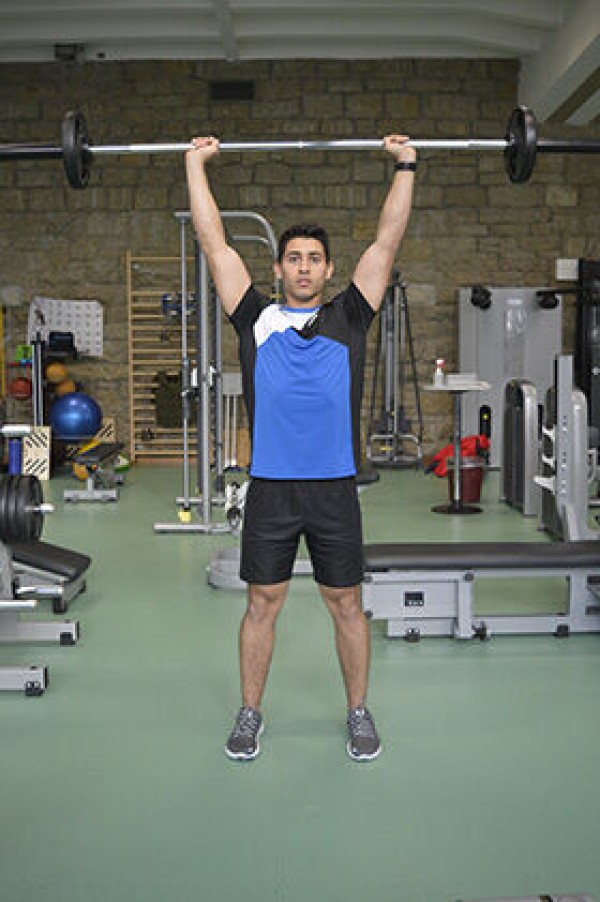
Standing upright, hold the barbell close to your body at shoulder height. Slowly push the weight up vertically and then return to the starting position.
Starting position:
- Stand upright with shoulders wide apart and back straight, torso tensed
- Hold the barbell in front of your shoulders
Finishing position:
- Hold the barbell high
- Arms (almost) fully extended, wrists fixed
Attention:
Work without momentum so that the movement comes from the shoulders.
Variant I:
The barbell can be lowered alternately once in front of and once behind the head.
Variant II:
To prevent support from the legs, the exercise can also be performed in a seated position.
1 barbell
Extension and flexion of the arms while standing
Power
Individual work
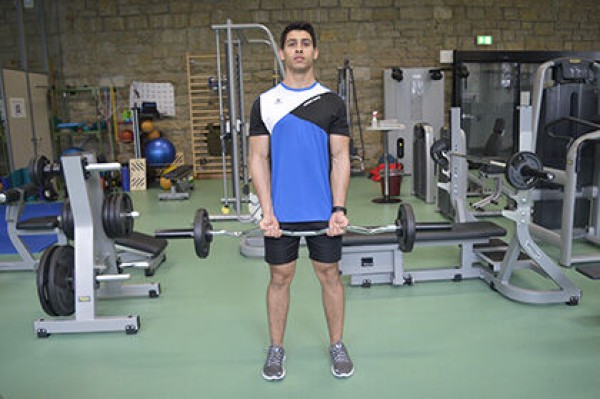
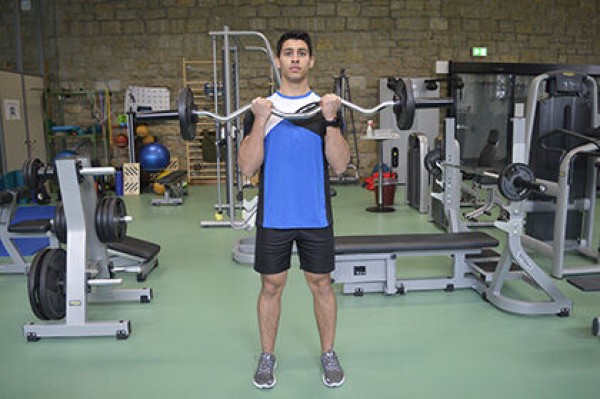
Stand with your feet hip-width apart and hold the barbell with an underhand grip with your arms hanging at thigh height. The hands grip the bar at shoulder width, with the upper arms resting against the body. Bend your arms to bring your hands towards your chest (barbell at shoulder height), whereby the movement only comes from the elbow joint, the rest of the body does not move. The weight is then slowly lowered to the starting position (arms almost fully extended).
Starting position:
- Stand with hips wide apart
- Barbell in lower grip at thigh level, arms (almost) straight
- Upper arms close to body
Finishing position:
- Arms bent, elbows pointing downwards and fixed
- Bar at shoulder height
Attention:
Only work with as much weight as you can control. If the load is too heavy, you will automatically lean back and work with momentum, which puts more strain on the back and less on the arm flexors.
Variant:
The exercise can also be performed with 2 dumbbells.
1 barbell
2 dumbbell ► variation of the exercise